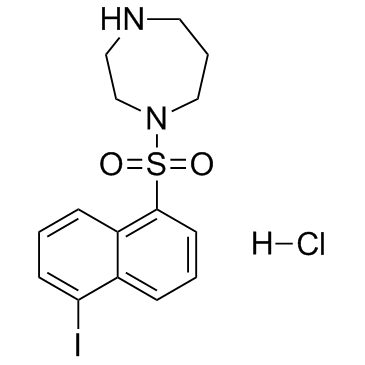All AbMole products are for research use only, cannot be used for human consumption.

In vitro: ML-7 hydrochloride inhibits rabbit portal vein α1-adrenoceptor NSCC with IC50 of 0.8 μM. The myosin light chain kinase (MLCK) inhibitor ML-7 hydrochloride (3 μ M and 10 μM) also attenuates the Dexmedetomidine (DMT)-induced contraction (p<0.05 versus control).
In vivo: In sham operated animals Evans Blue extravasation is not different between ML-7 hydrochloride and vehicle group (sham+vehicle: 0.26±0.02 OD/g; sham+ML-7: 0.26±0.02 OD/g). After CCI inhibition of MLCK with ML-7 results in a significant lower amount of intracerebral Evans Blue compared to vehicle treated animals (CCI+vehicle: 0.42±0.04 OD/g; CCI+ML-7: 0.35±0.05 OD/g, p=0.048)
| Cell Experiment | |
|---|---|
| Cell lines | MCF-10A cells, MDCK cells |
| Preparation method | Cells are treated with vehicle alone, Blebbistatin, ML-7, ML-9, latrunculin A or Y-27632 in media without serum at varying concentrations and time points before being fixed or prepared for FACS analysis. Untreated cells are also serum starved for the duration of the inhibitor treatment. Stock solutions of each agent are made in DMSO (50 μM Blebbistatin, 5 mM LA), 50% ethanol (10 mM ML-7), 70% ethanol (20 mM ML-9) or water (20 mM Y-27632) and are maintained at -20°C. |
| Concentrations | 40 μM |
| Incubation time | 16 h |
| Animal Experiment | |
|---|---|
| Animal models | Mice |
| Formulation | distilled water |
| Dosages | 1 mg/kg |
| Administration | i.p. |
| Molecular Weight | 452.74 |
| Formula | C15H18ClIN2O2S |
| CAS Number | 110448-33-4 |
| Solubility (25°C) | DMSO 40 mg/mL Water 1 mg/mL (ultrasonic) |
| Storage |
Powder -20°C 3 years ; 4°C 2 years In solvent -80°C 6 months ; -20°C 1 month |
| Related Products |
|---|
| PCL-PEG-MAL
PCL-PEG-MAL is an amphiphilic block copolymer consisting of polycaprolactone (PCL), polyethylene glycol (PEG) and maleimide (MAL) functional groups. PCL-PEG-MAL is used in targeted delivery systems, surface modification of nanomaterials, functionalisation of biomaterials and biosensing technologies for specific chemical linkages or biomolecular immobilisation. |
| DSPE-PEG-Streptavidin
DSPE-PEG-Streptavidin is an important biocoupling molecule widely used in biomedical research, especially in drug delivery, targeted therapies, immunodiagnostics and biosensors. Through the specific binding between streptavidin and biotin, DSPE-PEG-Streptavidin can help to achieve efficient loading and targeted action in targeted delivery systems. In addition, the molecule is widely used in molecular imaging and bioassays, especially for molecular recognition using the strong affinity between streptavidin and biotin in assay platforms that require high sensitivity and specificity. |
| E7107
E7107 is a first-in-class precursor messenger ribonucleic acid (pre-mRNA) spliceosome inhibitor. |
| KL044
KL044 is a stabilizer of the clock protein cryptochrome (CRY). KL044 is a potent chemical probe with a pEC50 value of 7.32, leading to the extension of the circadian period and repression of Per2 activity. |
| 2-(2-Methylphenoxy)-4H-1,3,2-benzodioxaphosphorin 2-oxide
2-(2-Methylphenoxy)-4H-1,3,2-benzodioxaphosphorin 2-oxide is a biochemical material that can be used in scientific research. |
All AbMole products are for research use only, cannot be used for human consumption or veterinary use. We do not provide products or services to individuals. Please comply with the intended use and do not use AbMole products for any other purpose.


Products are for research use only. Not for human use. We do not sell to patients.
© Copyright 2010-2024 AbMole BioScience. All Rights Reserved.
